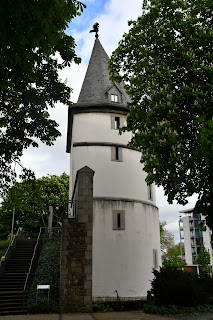Germany Trip – Day 4: Düsseldorf, Essen, and Dortmund
It was supposed to rain all day so I decided that from my base in Cologne, I would visit some of the less interesting areas in the region. I started the day in Düsseldorf, whose main claim to fame is being the capital of North-Rhine Westphalia. This fact is somewhat meaningless, though, considering how interconnected the whole region is. In fact, I took the suburban rail all the way from Cologne to get there. Similarly to Cologne, Düsseldorf has a silly name, as “Dorf” means “village” in German, and Düsseldorf is definitely not that.
Since the
wind was strong and the rain abundant, I did not spend much time touring the
city. After a brief walk past Town Hall and the monument to Düsseldorf
receiving city rights (or the Stadterhebungsmonument), I visited the Saint
Lambertus Basilica, whose remarkable altar was obstructed by technology set up
for some later event. I then hurried back to the metro and rode it to the main
station.
The second
leg of my journey took me to Essen, the historic centre of the industrial Ruhr
region. Essen is known for the Zollverein Coal Mine Industrial Complex, which has
long been out of use and now houses a massive museum dedicated to the Ruhr
Region. The mine was one of the largest in Europe and noted for its
architectural qualities. I have not been to many mines, but it seems the bar is
quite low, as the buildings of the Zollverein mine are uninspiringly bland.
I reached
the Zollverein by tram and spent about half an hour at the museum. I expected
it to have more machinery, but the museum focusses more on archaeological
discoveries and the daily lives of people living in the Ruhr region from the
prehistoric past to the modern era. By the time I finished my visit, the
weather had started to clear up a little, but it began to rain again by the
time I reached the Essen Minster. Founded in 845, the complex was rebuilt to
its 13th century form following bombing in WWII. The nearby treasury
also houses a number of beautiful artifacts, many of them made of gold and
containing the relics of saints.
Across the
road from the Essen Minster stands the Old Synagogue, built at the beginning of
the 20th century. Its interior is much less ornate than can be
gleaned from pictures of the original; while the synagogue largely escaped
bombing in WWII, its interior burned out and was converted into a museum.






























Comments
Post a Comment